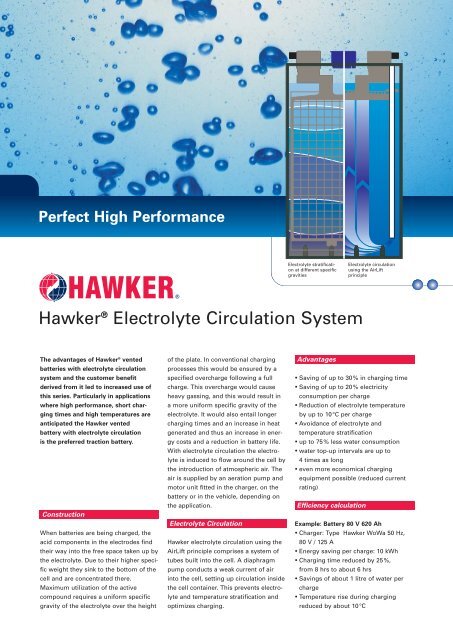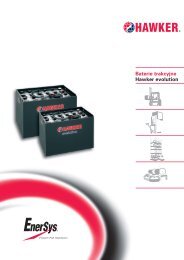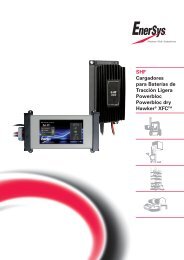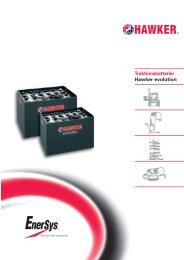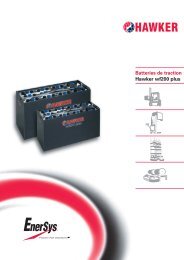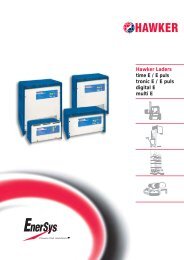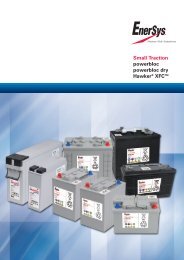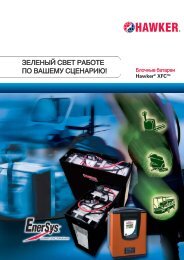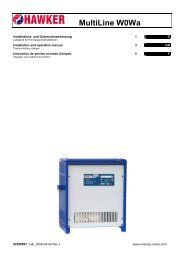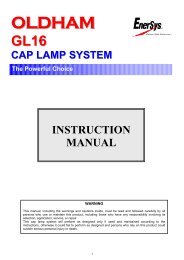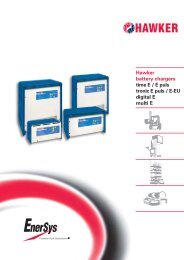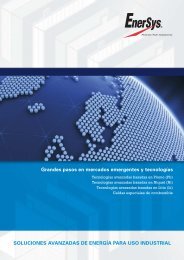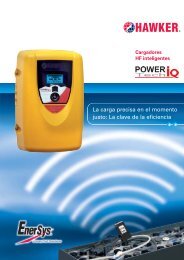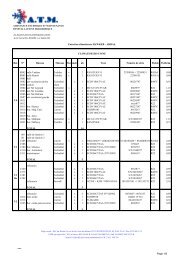16560 Leaflet Hawker EC gb.QXP:Hawker ... - EnerSys-Hawker
16560 Leaflet Hawker EC gb.QXP:Hawker ... - EnerSys-Hawker
16560 Leaflet Hawker EC gb.QXP:Hawker ... - EnerSys-Hawker
You also want an ePaper? Increase the reach of your titles
YUMPU automatically turns print PDFs into web optimized ePapers that Google loves.
Perfect High Performance<br />
Electrolyte stratification<br />
at different specific<br />
gravities<br />
<strong>Hawker</strong> ® Electrolyte Circulation System<br />
The advantages of <strong>Hawker</strong> ® vented<br />
batteries with electrolyte circulation<br />
system and the customer benefit<br />
derived from it led to increased use of<br />
this series. Particularly in applications<br />
where high performance, short charging<br />
times and high temperatures are<br />
anticipated the <strong>Hawker</strong> vented<br />
battery with electrolyte circulation<br />
is the preferred traction battery.<br />
Construction<br />
When batteries are being charged, the<br />
acid components in the electrodes find<br />
their way into the free space taken up by<br />
the electrolyte. Due to their higher specific<br />
weight they sink to the bottom of the<br />
cell and are concentrated there.<br />
Maximum utilization of the active<br />
compound requires a uniform specific<br />
gravity of the electrolyte over the height<br />
of the plate. In conventional charging<br />
processes this would be ensured by a<br />
specified overcharge following a full<br />
charge. This overcharge would cause<br />
heavy gassing, and this would result in<br />
a more uniform specific gravity of the<br />
electrolyte. It would also entail longer<br />
charging times and an increase in heat<br />
generated and thus an increase in energy<br />
costs and a reduction in battery life.<br />
With electrolyte circulation the electrolyte<br />
is induced to flow around the cell by<br />
the introduction of atmospheric air. The<br />
air is supplied by an aeration pump and<br />
motor unit fitted in the charger, on the<br />
battery or in the vehicle, depending on<br />
the application.<br />
Electrolyte Circulation<br />
<strong>Hawker</strong> electrolyte circulation using the<br />
AirLift principle comprises a system of<br />
tubes built into the cell. A diaphragm<br />
pump conducts a weak current of air<br />
into the cell, setting up circulation inside<br />
the cell container. This prevents electrolyte<br />
and temperature stratification and<br />
optimizes charging.<br />
Advantages<br />
Electrolyte circulation<br />
using the AirLift<br />
principle<br />
Saving of up to 30% in charging time<br />
Saving of up to 20% electricity<br />
consumption per charge<br />
Reduction of electrolyte temperature<br />
by up to 10°C per charge<br />
Avoidance of electrolyte and<br />
temperature stratification<br />
up to 75% less water consumption<br />
water top-up intervals are up to<br />
4 times as long<br />
even more economical charging<br />
equipment possible (reduced current<br />
rating)<br />
Efficiency calculation<br />
Example: Battery 80 V 620 Ah<br />
Charger: Type <strong>Hawker</strong> WoWa 50 Hz,<br />
80 V / 125 A<br />
Energy saving per charge: 10 kWh<br />
Charging time reduced by 25%,<br />
from 8 hrs to about 6 hrs<br />
Savings of about 1 litre of water per<br />
charge<br />
Temperature rise during charging<br />
reduced by about 10°C


